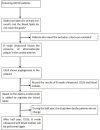Effect of evolocumab on the progression of intraplaque neovascularization of the carotid based on contrast-enhanced ultrasonography (EPIC study): A prospective single-arm, open-label study
- PMID: 36686711
- PMCID: PMC9846542
- DOI: 10.3389/fphar.2022.999224
Effect of evolocumab on the progression of intraplaque neovascularization of the carotid based on contrast-enhanced ultrasonography (EPIC study): A prospective single-arm, open-label study
Abstract
Background and Purpose: The aim of this study was to explore the effect of half a year of evolocumab plus moderate-intensity statin treatment on carotid intraplaque neovascularization (IPN) and blood lipid levels. Methods: A total of 31 patients with 33 carotid plaques who received evolocumab plus statin treatment were included. Blood lipid levels, B-mode ultrasound and contrast-enhanced ultrasonography (CEUS) at baseline and after half a year of evolocumab plus statin therapy were collected. The area under the curve (AUC) reflected the total amount of acoustic developer entering the plaque or lumen within the 180 s measurement period. The enhanced intensity reflected the peak blood flow intensity during the monitoring period, and the contrast agent area reflected the area of vessels in the plaques. Results: Except for high-density lipoprotein cholesterol (HDL-c), all other lipid indices decreased. Compared with baseline, low-density lipoprotein cholesterol (LDL-c) decreased by approximately 57% (p < 0.001); total cholesterol (TC) decreased by approximately 34% (p < 0.001); small dense low-density lipoprotein (sd-LDL) decreased by approximately 52% (p < 0.001); and HDL-c increased by approximately 20% (p < 0.001). B-mode ultrasonography showed that the length and thickness of the plaque and the hypoechoic area ratio were reduced (p < 0.05). The plaque area, calcified area ratio, and lumen cross-sectional area changed little (p > 0.05). CEUS revealed that the area under the curve of plaque/lumen [AUC (P/L)] decreased from 0.27 ± 0.13 to 0.19 ± 0.11 (p < 0.001). The enhanced intensity ratio of plaque/lumen [intensity ratio (P/L)] decreased from 0.37 ± 0.16 to 0.31 ± 0.14 (p = 0.009). The contrast agent area in plaque/area of plaque decreased from 19.20 ± 13.23 to 12.66 ± 9.59 (p = 0.003). The neovascularization score decreased from 2.64 ± 0.54 to 2.06 ± 0.86 (p < 0.001). Subgroup analysis based on statin duration (<6 months and ≥6 months) showed that there was no significant difference in the AUC (P/L) or intensity ratio (P/L) at baseline or after half a year of evolocumab treatment. Conclusion: This study found that evolocumab combined with moderate-intensity statins significantly improved the blood lipid profile and reduced carotid IPN. Clinical Trial Registration: https://www.clinicaltrials.gov; identifier: NCT04423406.
Keywords: atherosclerotic cardiovascular disease; contrast-enhanced ultrasonography; evolocumab; intra-plaque neovascularization; proprotein convertase subtilisin-kexin type 9.
Copyright © 2023 Chen, Zhao, Lei, Qi, Xue, Meng, Zhang, Zhang, Wang, Zhu, Cheng, Wang, Bi, Song, Jin, Niu, An, Li, Huo, Zhao and Li.
Conflict of interest statement
The authors declare that the research was conducted in the absence of any commercial or financial relationships that could be construed as a potential conflict of interest.
Figures


Similar articles
-
Effect of combining evolocumab with statin on carotid intraplaque neovascularization in patients with premature coronary artery disease (EPOCH).Atherosclerosis. 2024 Apr;391:117471. doi: 10.1016/j.atherosclerosis.2024.117471. Epub 2024 Feb 13. Atherosclerosis. 2024. PMID: 38493669
-
Effect of moderate-intensity statin on carotid intraplaque neovascularization of coronary artery disease: a retrospective cohort study.Quant Imaging Med Surg. 2024 Feb 1;14(2):1660-1672. doi: 10.21037/qims-23-1104. Epub 2024 Jan 23. Quant Imaging Med Surg. 2024. PMID: 38415148 Free PMC article.
-
Evolocumab treatment reduces carotid intima-media thickness in paediatric patients with heterozygous familial hypercholesterolaemia.Eur J Prev Cardiol. 2024 Nov 12:zwae369. doi: 10.1093/eurjpc/zwae369. Online ahead of print. Eur J Prev Cardiol. 2024. PMID: 39531353
-
Additive effects of ezetimibe, evolocumab, and alirocumab on plaque burden and lipid content as assessed by intravascular ultrasound: A PRISMA-compliant meta-analysis.Medicine (Baltimore). 2022 Oct 14;101(41):e31199. doi: 10.1097/MD.0000000000031199. Medicine (Baltimore). 2022. PMID: 36254013 Free PMC article.
-
Contrast-Enhanced Ultrasound to Assess Carotid Intraplaque Neovascularization.Ultrasound Med Biol. 2020 Mar;46(3):466-478. doi: 10.1016/j.ultrasmedbio.2019.10.020. Epub 2019 Nov 29. Ultrasound Med Biol. 2020. PMID: 31791553
Cited by
-
Expression of pro- and anti-inflammatory cytokines during anti-proprotein convertase subtilisin/kexin type 9 therapy in patients with statin-resistant familial hypercholesterolemia.Front Cardiovasc Med. 2024 Jul 18;11:1417044. doi: 10.3389/fcvm.2024.1417044. eCollection 2024. Front Cardiovasc Med. 2024. PMID: 39091354 Free PMC article.
-
Anti-urease therapy: a targeted approach to mitigating antibiotic resistance in Helicobacter pylori while preserving the gut microflora.Gut Pathog. 2025 May 28;17(1):37. doi: 10.1186/s13099-025-00708-1. Gut Pathog. 2025. PMID: 40437630 Free PMC article. Review.
-
PCSK9 Inhibitors in Cancer Patients Treated with Immune-Checkpoint Inhibitors to Reduce Cardiovascular Events: New Frontiers in Cardioncology.Cancers (Basel). 2023 Feb 22;15(5):1397. doi: 10.3390/cancers15051397. Cancers (Basel). 2023. PMID: 36900189 Free PMC article. Review.
-
Targeting telomerase with MST-312 leads to downregulation of CCND1, MDM2, MYC, and HSP90AA1 and induce apoptosis in Jurkat cell line.Med Oncol. 2024 Oct 14;41(11):267. doi: 10.1007/s12032-024-02412-7. Med Oncol. 2024. PMID: 39400638
-
Research Progress of Antioxidants in Oxidative Stress Therapy after Spinal Cord Injury.Neurochem Res. 2023 Dec;48(12):3473-3484. doi: 10.1007/s11064-023-03993-x. Epub 2023 Aug 1. Neurochem Res. 2023. PMID: 37526867 Review.
References
-
- Colhoun H. M., Betteridge D. J., Durrington P. N., Hitman G. A., W Neil Ha, Livingstone S. J., et al. (2004). Primary prevention of cardiovascular disease with atorvastatin in type 2 diabetes in the collaborative atorvastatin diabetes study (cards): Multicentre randomised placebo-controlled trial. Lancet 364, 685–696. 10.1016/S0140-6736(04)16895-5 - DOI - PubMed
-
- Cui L., Xing Y., Zhou Y., Wang L., Liu K., Zhang D., et al. (2021). Carotid intraplaque neovascularisation as a predictive factor for future vascular events in patients with mild and moderate carotid stenosis: An observational prospective study. Ther. Adv. Neurol. Disord. 14, 17562864211023992. 10.1177/17562864211023992 - DOI - PMC - PubMed
-
- Diaz R., Li Q. H., Bhatt D. L., Bittner V. A., Baccara-Dinet M. T., Goodman S. G., et al. (2021). Intensity of statin treatment after acute coronary syndrome, residual risk, and its modification by alirocumab: Insights from the odyssey outcomes trial. Eur. J. Prev. Cardiol. 28, 33–43. 10.1177/2047487320941987 - DOI - PubMed
Associated data
LinkOut - more resources
Full Text Sources
Medical

